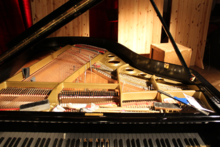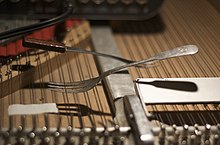Prepared piano

The prepared piano is a technique introduced by John Cage around 1940 of inserting objects such as erasers, nails, paper, etc. at certain points in the stringed choirs of a piano , which produce either multi-sounds , flageolet tones or percussive sounds . A similar effect was already known in the 18th century with the early fortepiano , on which strips of paper were placed between the string and the hammer, which produced special sound effects.
In the meantime the technique of preparation is widespread, both in the field of art music as well as in jazz and in the field of dark wave .
History of origin
Sound composition
Until well into the 20th century, various composers kept exploring new ways of expanding the sound spectrum of the piano.
Ferruccio Busoni, for example, had doubts about the tempered tuning of the piano and criticized the training of the western ear, which is adapted by habit so "that it can perceive finer differentiations only in the sense of impurity." Charles Ives wrote his three quarter tone pieces due to the lack of microtonal instruments (1925) for two pianos that were offset by a quarter tone . What they had in common was the concentration on the expansion of the tone scale, the complete steplessness of which could only be achieved with electronic music.
The essential innovation, which has given Cage a place it deserves in the history of music and especially the piano sonata, is therefore also the change in the timbre through changes to the piano that can almost be called manual changes: the introduction of foreign objects into the sound body or the strings. The manipulation of the sound on the instrument itself distinguishes it from the innovations of other composers.
The idea of preparing the piano strings itself, however, does not go back to Cage. Henry Cowell was a pioneer in changing the original sound by interfering with the vibration behavior of the piano strings . As his student, Cage had assisted him more frequently during his studies when he began to mute strings in his piano pieces since 1923 in order to achieve sound manipulations and harmonic effects . Cowell had tried to get the dampening mostly through fingers and hands. In a few exceptional cases he also used foreign objects, but never went as far as his pupil later.
The composition with the help of unfamiliar noises and the import of sounds that were previously regarded as non-musical can also be found in many of Erik Satie's works , such as the Parade ; other composers also experimented with it.
Cage worked with everyday objects. He used screws, nails, bolts and sealing materials made of felt fiber. Even a cake stand and erasers found their way onto the strings. When Cage finally found the suitable preparation material, which not only stuck between the strings, but also produced the desired percussive to bell-like sounds, he had at the same time preserved the natural way of playing the piano: Once you got used to the tonal characteristics of pianistic possibilities , the instrument could be played in all its virtuoso possibilities - albeit a little quieter than usual.
These sound manipulations are what make the real revolution in piano music. The original colors of the notes changed drastically and could often hardly be recognized as such, depending on what the preparation consisted of and where it was attached to the strings.
In his Credo formulated in 1937, Cage had already formulated his goal:
"It is important to explore the academically forbidden, non-musical sound field, as far as this is manually possible."
After Schönberg had already released the tone scale from the predominance of a tonal center and de-hierarchized the twelve tones, Cage raised this principle to a further level by extending Schoenberg's concept to the entire sound space. He took into account his opinion, coined at an early stage, that “things don't just have to be beautiful.” He was striving for the equality of all sounds without considering their aesthetic quality. He therefore intentionally included unpleasant sounds in the sound catalog of the prepared piano.
In the case of the Sonatas and Interludes, for example, Cage's most famous work for prepared piano, the sound in the lower registers - especially due to the double preparation with metal or plastic and rubber - is clearly clouded with clear associations with percussion instruments . In the middle registers of the keyboard, muted timbres dominate, in the higher registers the sound increases in brightness.
Use as a percussion ensemble
When, in 1940, for the music to accompany the Bacchanale - it was supposed to be the first piece for prepared piano - the dancer Syvilla Fort, John Cage first covered the piano strings with different materials and thus generated drum-like sounds and noises, he was looking for a way to get into the Cornish Theater in Seattle , where the performance was to take place, to create his idea of percussion-related African music: the theater itself only offered space for a grand piano.
With the conception of the prepared piano, John Cage placed himself at the forefront of a movement of the 20th century.
With his orchestral pieces - above all Le sacre du printemps - Igor Stravinsky had promoted the emancipation of rhythm and made percussion instruments popular for composers in the years that followed their premiere in 1913.
In his piano pieces - such as piano rag music - the piano takes on the role of a percussion instrument, which does not suppress tonality and harmony, but gives them a secondary function. The pioneer here was Sergei Prokofiev , who created his own style of motor music with his Toccata from 1912. Also Béla Bartók's cluster-like tone clusters in the Sonata refer to a weighting of the rhythmic structure of musical material.
With his interest in drums and percussion, John Cage followed a phenomenon of the times, but had already dealt intensively with the acoustic possibilities of this type of instrument during his studies with Henry Cowell, and in his musical credo of 1937 he also came to the conclusion that the future of Music can be seen in electronic sound generation, but due to the immaturity of electrical instruments, drum music can be accepted as a temporary solution:
"Percussion music is a transitional solution for piano-influenced music until the final music of the future is reached."
With the prepared piano, he took this step extremely radically and with tradition-delimiting consistency: The change from harmonic and melodic functions of the piano to pure sound impressions - a large part of which is percussive in nature - drives the suppression of tonal relationships, apart from parallel musical phenomena such as the Dodecaphony , to the extreme.
That the instrument was more than an interim solution until the availability of synthesizers - which can provide the sound manipulations without complex preparatory work - shows u. a. the late composition 34'46.776 : Cage remained faithful to the prepared piano when the long-awaited means of electronic sound generation were finally available in satisfactory quality.

Current use
In addition to Cage, other composers also used the prepared piano. Independently of Cage's own experiments, the Mexican Conlon Nancarrow composed exclusively for player piano from 1947 on and prepared some of the piano strings for sound reasons. Furthermore have Earle Brown , Boris Berman , Ruth Schonenthal , Alfred Schnittke ( Concerto Grosso # 1. ,) Arvo Part ( Tabularasa ;... In a version for 2 violins, Streichorch u prep piano) or Mario Bertoncini works written for prepared piano . With the preparation, the piano sound comes close to that of Southeast Asian gamelan music. This sound effect contributed significantly to the creation of the compositions Balijava (1971) and Mandala (1972) by Peter Michael Hamel . Currently composers such as Iancu Dumitrescu , Iris ter Schiphorst , Ana-Maria Avram , Joseph Schwantner , Se-Lien Chuang , Thuon Burtevitz and Dietmar Bonnen should be mentioned.
Since the late 1960s, preparation as an extended technique has also migrated to free jazz. Pianists like Keith Tippett , Irène Schweizer or Alexander von Schlippenbach usually prepare several strings by placing blocks of wood or metal objects in the grand piano. Numerous other pianists such as Philip Zoubek , Simon Nabatov , Myra Melford , Sophie Agnel and Sylvie Courvoisier have followed them. They often change the preparation during a piece. The use of the prepared piano has not been reserved for the avant-garde for a long time: Keith Jarrett already worked with this technique in his solo concerts in Bremen / Lausanne , which Esbjörn Svensson also used again and again at the concerts of est . The Australian jazz pianist and new music composer Anthony Pateras sees one of his main focuses in expanding the piano sound space without electronic aids. Chris Burn includes a variety of drums, cymbals, bells and other sounding objects in the prepared game. Andrea Neumann plays on a keyboard-free "indoor piano" that she prepares with many different everyday objects.
The dark wave band Deine Lakaien also uses a prepared grand piano on their acoustic performances. Also used Aphex Twin for his 2001 released album Drukqs numerous recordings of prepared pianos. The German musician Volker Bertelmann released the album The Prepared Piano in 2005 under the pseudonym Hauschka , on which he dealt intensively with the possibilities of prepared pianos.
The idea of changing the timbre has been carried over to other instruments such as the guitar; Keith Rowe and Hans Reichel explored the technique of preparation on the electric guitar , which is used today in avant-garde rock by bands like Sonic Youth ; special instruments such as the third bridge guitar have also been developed.
The Luthéal is an early example of mechanical changes in the sound of the piano .
literature
- Monika Fürst-Heidtmann: The prepared piano of John Cage . Gustav Bosse Verlag, Regensburg 1979, ISBN 978-3-7649-2183-5 .
- Tzenka Dianova: John Cage's Prepared Piano. The nuts & bolts . Mutasis Books Victoria, 2008, ISBN 978-0-9809657-0-4 .
Individual evidence
- ↑ Ferrucio Busoni: Draft of a new aesthetic of music art . Quoted from Monika Fürst-Heidtmann: The prepared piano of John Cage . Gustav Bosse Verlag, Regensburg 1979, p. 3
- ^ A b John Cage: The future of Music: Credo . 1937, p. 4
- ^ John Cage: The future of Music: Credo . 1937, p. 5. In the original: "Percussion music is a contemporary transition from keyboard-influenced music to the all-sound music of the future."

